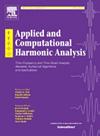The spectral barycentre of a set of graphs with community structure
IF 3.2
2区 数学
Q1 MATHEMATICS, APPLIED
引用次数: 0
Abstract
The notion of barycentre graph is of crucial importance for machine learning algorithms that process graph-valued data. The barycentre graph is a “summary graph” that captures the mean topology and connectivity structure of a training dataset of graphs. The construction of a barycentre requires the definition of a metric to quantify distances between pairs of graphs. In this work, we use a multiscale spectral distance that is defined using the eigenvalues of the normalized graph Laplacian. The eigenvalues – but not the eigenvectors – of the normalized Laplacian of the barycentre graph can be determined from the optimization problem that defines the barycentre. In this work, we propose a structural constraint on the eigenvectors of the normalized graph Laplacian of the barycentre graph that guarantees that the barycentre inherits the topological structure of the graphs in the sample dataset. The eigenvectors can be computed using an algorithm that explores the large library of Soules bases. When the graphs are random realizations of a balanced stochastic block model, then our algorithm returns a barycentre that converges asymptotically (in the limit of large graph size) almost-surely to the population mean of the graphs. We perform Monte Carlo simulations to validate the theoretical properties of the estimator; we conduct experiments on real-life graphs that suggest that our approach works beyond the controlled environment of stochastic block models.
一类具有群落结构的图的谱质心
重心图的概念对于处理图值数据的机器学习算法至关重要。重心图是一种“汇总图”,它捕获图的训练数据集的平均拓扑和连接结构。质心的构造需要定义度量来量化图对之间的距离。在这项工作中,我们使用了一个多尺度光谱距离,它是用归一化图拉普拉斯的特征值定义的。质心图的归一化拉普拉斯函数的特征值(而不是特征向量)可以从定义质心的优化问题中确定。在这项工作中,我们提出了一个质心图的归一化图拉普拉斯特征向量的结构约束,以保证质心继承样本数据集中图的拓扑结构。特征向量可以使用一种算法来计算,该算法可以探索大量的Soules碱基库。当图是平衡随机块模型的随机实现时,我们的算法返回的重心几乎肯定会渐近地收敛于图的总体平均值(在大图大小的限制下)。我们进行蒙特卡罗模拟来验证估计器的理论性质;我们对现实生活中的图表进行了实验,表明我们的方法在随机块模型的受控环境之外也有效。
本文章由计算机程序翻译,如有差异,请以英文原文为准。
求助全文
约1分钟内获得全文
求助全文
来源期刊

Applied and Computational Harmonic Analysis
物理-物理:数学物理
CiteScore
5.40
自引率
4.00%
发文量
67
审稿时长
22.9 weeks
期刊介绍:
Applied and Computational Harmonic Analysis (ACHA) is an interdisciplinary journal that publishes high-quality papers in all areas of mathematical sciences related to the applied and computational aspects of harmonic analysis, with special emphasis on innovative theoretical development, methods, and algorithms, for information processing, manipulation, understanding, and so forth. The objectives of the journal are to chronicle the important publications in the rapidly growing field of data representation and analysis, to stimulate research in relevant interdisciplinary areas, and to provide a common link among mathematical, physical, and life scientists, as well as engineers.
 求助内容:
求助内容: 应助结果提醒方式:
应助结果提醒方式:


